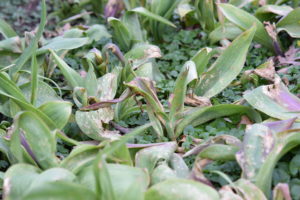For over a one-half century Kingwood Center in Mansfield, Ohio has been widely known for their fabulous tulip displays every spring. Over the past few years Kingwood’s garden staff had noted a decline in bloom because of a disease identified as “Tulip Fire” (Botrytis tulipae).
This fungal botrytis disease tends to accumulate in the soil in wait of an ideal environmental weather pattern. In previous years the staff had treated tulip beds with appropriate fungicides, but spring 2017 was the year of “the perfect storm”. Most of the tulips in six large beds were lost to this botrytis disease. Combined with an unprecedented attack from rodents, garden staff had to pull out the tulips and posted signs of the “crop failure”.
“The problem has been accumulating for 62 years”, says Chuck Gleaves, garden director, “and no immediate solution is expected”. Most gardeners have learned to adopt principles of crop rotation. Pesticide applications will not work here. All the tulips were removed from the six affected beds. This fall garden staff plan to plant hyacinths. No tulips will be planted in the affected beds for a minimum of two years. Planting costs will increase because hyacinths are considerably more expensive over tulips.
Gleaves promises that Kingwood will continue to grow lots of tulips, but in different areas and rotate hyacinths with tulips in selected beds. Over time, they hope to reduce the accumulated inoculum of Botrytis.
Additional Notes:
Non-chemical control
- Check bulbs carefully and discard any with signs of the small black sclerotia in the outer scales, or with any signs of decay
- Remove infected bulbs promptly to avoid contaminating the soil with sclerotia
- Do not plant tulips for at least 3 years in sites where tulip fire has occurred
- If a contaminated site must be replanted, dig the ground deeply to try and bury the contaminated upper layers deep enough to be below planting depth
- Rotate tulips to new garden areas each year to avoid fungal scerotia buildup in soil.
- Treat tulips as annuals and remove them after flowering.
Chemical control: Integrate chemical tactics with cultural controls. Alternate or tank-mix fungicides (not use same fungicide all the time):
- Chipco 26019
- Daconil
- Cleary’s 3336 EG or OHP 6672 (Thiophanate methyl).



 Posted in
Posted in 
